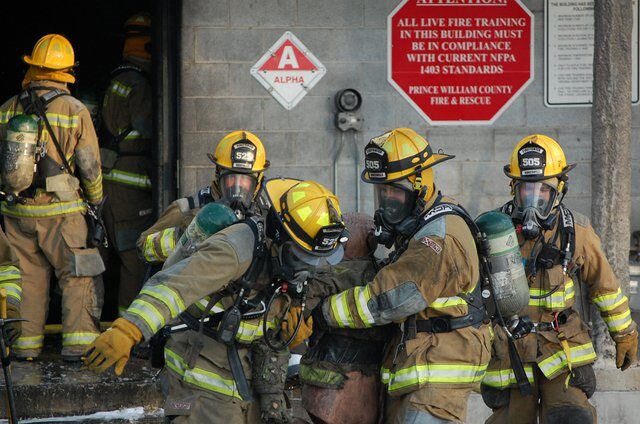Overview
It's not all like the movie Backdraft, but firefighting remains one of the most challenging and rewarding jobs on Earth. Every day, firefighters are called upon to overcome the extreme. Whether it is attacking or suppressing fires, responding to serious vehicle crashes, or helping the injured or ill, these brave men and women respond to the call for help day or night, 365 days a year.

Trained in the latest in fire attack strategy and tactics, and equipped with the best apparatus and tools available, the firefighters of the Nokesville Vol. Fire & Rescue Department respond to many "working" fires each year, including structures, vehicles, dumpsters, and brush. The number of fire "calls" far exceeds the number of actual fires. Many fires are out upon arrival, or they were simply “good intent” calls with no fire found. Each fire call, however, requires a rapid, professional response from each member of the crew.
Firefighting is physically and mentally demanding work. To accomplish the firefighting mission successfully, NVFD firefighters complete rigorous training programs, both at the Prince William County Public Safety Training Center (PSTC) and at our stations (in-house).
Firefighter training begins in the station. New members are required to go through some basic fireground training before they are allowed to ride the apparatus, even as an observer. This initial, basic training is called "red hat" training.
The red hat (recruit) training covers fire hoses, ladders, protective clothing, ropes and knots, and other basic fireground operations. The emphasis during this training is on safety. When the new member has successfully completed the red hat manual exam, three additional courses are required before the member can begin riding the apparatus as a red hat. These courses include CPR for healthcare providers, hazardous materials awareness for first responders, and a course on infection control.
In conjunction with becoming a red hat, or shortly thereafter, members begin formal firefighter training at the Prince William County Public Safety Training Center in Nokesville, VA. Most classes are held two evenings a week and one day on the weekend. The academy has a large burn building that provides live fire exercises for realistic training. Classes are a combination of lectures in the classroom and practical, hands-on skill testing under the direction of some of Prince William County's most experienced fire instructors.
Firefighter I teaches the basics of firefighting including equipment use, fire behavior, ladders, extrication, rescue, ventilation, and safety. One full day is devoted to automotive firefighting, and two days are devoted to rescue scenarios. Near the end of the course, two days are spent working through the burn building in live fire exercises. During these structure fire days, crews will face six or seven real house fires in an eight-hour shift.
Firefighter II course teaches more advanced skills, some basic command decision making, and many more structure fire scenarios. Firefighter II includes another day of structural firefighting, including standpipe evolutions and interior attacks with large diameter attack lines.
HazMat Awareness, Operations, & Technician. With interstate highways, railways, and hazardous material processing and storage in the county, HazMat training is a must. Hazardous Materials management is taught at a variety of levels including HazMat Awareness, which teaches identification and evaluation of hazardous materials; HazMat Operations which covers containment and mitigation of hazardous materials and gross decontamination; and finally, HazMat Technician which is the most advanced level of hazardous materials training. Extensive training in supervising a hazardous materials incident and dealing with extremely difficult hazardous materials situations is conducted during the Technician level course.
Emergency Vehicle Operator Course (EVOC) II & III. Driving a fire truck is not quite like driving your average car or even a large SUV. It takes special skills to handle the heavy and large emergency vehicles in traffic and under stressful response conditions. To this end, driver candidates are certified in EVOC, and for fire apparatus, that typically includes class II (Ambulances) or class III (Pumpers and Trucks).
Officer I, II, and III. The Officer series teaches fire leaders incident command, fire attack strategy and tactics, fire investigation, management, administration, human resources, and other related disciplines.
Instructor I helps experienced firefighters become better instructors by teaching how to teach. The course teaches teaching techniques and then requires each student to give a fire department-related presentation as part of the final exam. Instructor II & III teach how to create lesson plans and how to put together a course outline to teach classes within the fire service.
Join Us!
If firefighting sounds exciting to you and you think you have the mental and physical strength to meet the demands of the profession, join our volunteer team to serve the community! All training and necessary equipment is provided by the NVFDRS with a commitment to maintain good operational status with the department.